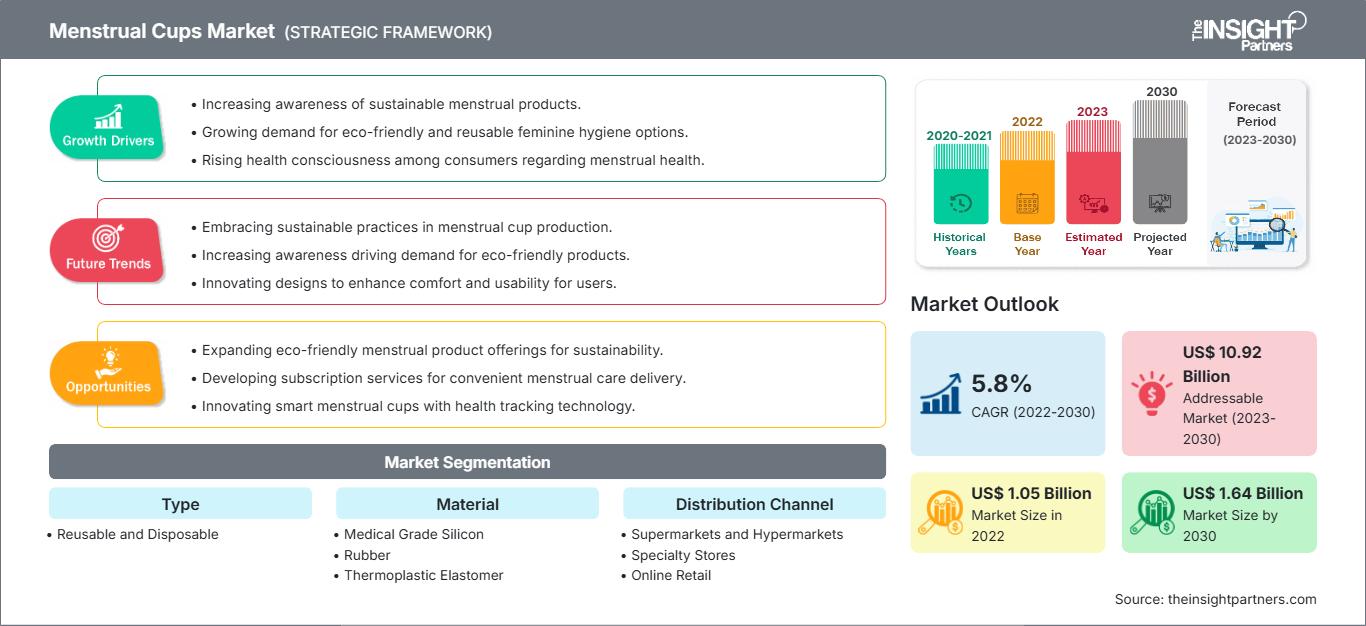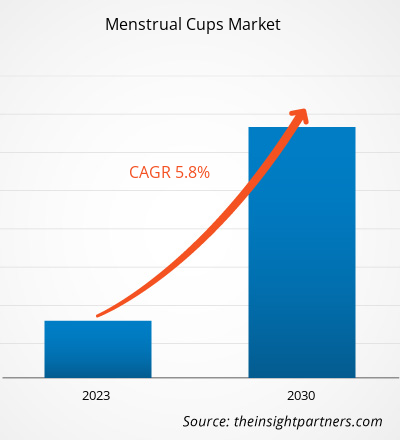[Rapport de recherche] Le marché des coupes menstruelles était évalué à 1 050,81 millions de dollars américains en 2022 et devrait atteindre 1 644,06 millions de dollars américains d'ici 2030 ; il devrait enregistrer un TCAC de 5,8 % entre 2022 et 2030.
Analyses du marché et point de vue des analystes :
Les coupes menstruelles sont des dispositifs réutilisables en forme de cloche conçus pour l'hygiène féminine pendant les règles. Généralement fabriquées en silicone ou en caoutchouc de qualité médicale, ces coupes sont insérées dans le vagin pour recueillir le flux menstruel plutôt que de l'absorber comme les tampons ou les serviettes hygiéniques traditionnels. Elles créent une étanchéité pour éviter les fuites et peuvent être portées jusqu'à 12 heures avant de devoir être vidées, offrant une alternative durable et économique aux produits jetables. Les coupes menstruelles gagnent en popularité grâce à leurs avantages environnementaux et à leurs économies à long terme par rapport aux solutions d'hygiène menstruelle traditionnelles.
Moteurs de croissance et défis :
La forte demande de produits menstruels durables est l'un des principaux moteurs du marché des coupes menstruelles. Ces dernières années, on a assisté à une évolution mondiale vers le développement durable, les consommateurs étant de plus en plus conscients de l'impact environnemental des produits menstruels jetables traditionnels. Les serviettes et tampons traditionnels contribuent de manière significative aux déchets plastiques, et leur production consomme des ressources et de l'énergie. Chaque année, une femme moyenne jette près de 150 kilogrammes de déchets non biodégradables. Rien qu'en Inde, environ 121 millions de femmes et de filles utilisent en moyenne huit serviettes jetables et non compostables par mois, générant 1,021 milliard de déchets de serviettes hygiéniques par mois, 12,3 milliards de déchets de serviettes hygiéniques par an et 113 000 tonnes de déchets menstruels annuels. Les coupes menstruelles sont devenues un choix de premier plan, car les personnes recherchent des alternatives écologiques en raison de leur caractère réutilisable. Cette conscience environnementale accrue incite les consommateurs à opter pour des produits minimisant leur empreinte écologique, ce qui stimule la demande de coupes menstruelles.
La demande croissante de produits menstruels durables est étroitement liée à un mouvement plus large en faveur de la santé et du bien-être des femmes. Les consommateurs privilégient de plus en plus les produits non seulement respectueux de l'environnement, mais aussi sûrs et bénéfiques pour leur santé. Les coupes menstruelles, généralement fabriquées en silicone, caoutchouc ou élastomères thermoplastiques de qualité médicale, sont considérées comme sûres et hygiéniques, réduisant les risques d'irritation et de réactions allergiques souvent associés aux produits traditionnels. L'alignement des coupes menstruelles sur la durabilité environnementale et la santé des femmes contribue à leur attrait et à leur popularité croissante.
Personnalisez ce rapport en fonction de vos besoins
Vous bénéficierez d’une personnalisation sur n’importe quel rapport - gratuitement - y compris des parties de ce rapport, ou une analyse au niveau du pays, un pack de données Excel, ainsi que de profiter d’offres exceptionnelles et de réductions pour les start-ups et les universités
Marché des coupes menstruelles: Perspectives stratégiques

-
Obtenez les principales tendances clés du marché de ce rapport.Cet échantillon GRATUIT comprendra une analyse de données, allant des tendances du marché aux estimations et prévisions.
L'appel à la durabilité des produits menstruels a été amplifié par divers groupes de défense, ONG et initiatives gouvernementales visant à sensibiliser le public à l'impact environnemental des options jetables. Les campagnes de promotion de la menstruation durable ont joué un rôle crucial pour sensibiliser le public aux avantages des alternatives réutilisables comme les coupes menstruelles. La visibilité et l'approbation croissantes des pratiques menstruelles durables contribuent à un changement positif dans les attitudes des consommateurs, favorisant une plus grande acceptation et adoption des coupes menstruelles.
La demande de produits menstruels durables est également alimentée par une jeune génération de consommateurs qui privilégie les choix éco-responsables. Les Millennials et la Génération Z, en particulier, stimulent la demande de produits durables et éthiques dans divers secteurs, y compris les soins personnels. La sensibilisation et les préférences de ces groupes démographiques influencent les tendances du marché, et les coupes menstruelles, en tant qu'option durable et avant-gardiste, correspondent parfaitement à leurs valeurs. À mesure que le pouvoir d'achat de cette population continue de croître, la demande de coupes menstruelles va également croître, renforçant leur position sur le marché en tant que produit menstruel durable de premier plan.
Cependant, la perception et la méconnaissance des consommatrices représentent des freins importants sur le marché des coupes menstruelles, impactant les taux d'adoption à l'échelle mondiale. De nombreuses personnes restent mal informées sur les avantages des coupes menstruelles en raison d'un manque d'éducation et de campagnes de sensibilisation complètes. La méconnaissance du produit et de ses avantages, tels que la rentabilité, la réduction de l'impact environnemental et la durée de port prolongée, contribue à la réticence des utilisatrices potentielles à abandonner les produits menstruels traditionnels. Ce manque de connaissances peut engendrer des idées fausses et des inhibitions, entravant l'acceptation plus large des coupes menstruelles comme une alternative viable et pratique.
L'hésitation à utiliser les coupes menstruelles est souvent liée à des inquiétudes quant à la difficulté de leur insertion et de leur retrait. De nombreuses consommatrices perçoivent la courbe d'apprentissage associée à l'utilisation des coupes menstruelles comme un obstacle, supposant qu'elles requièrent un niveau de compétence ou de confort qu'elles ne possèdent peut-être pas. Le manque de compréhension de la simplicité d'utilisation des coupes menstruelles et de leurs bienfaits potentiels pour la santé contribue à cette appréhension. Pour surmonter ces idées reçues et ces idées reçues, des efforts de sensibilisation ciblés sont nécessaires afin de mettre en avant la facilité d'utilisation, le confort et l'impact environnemental positif des coupes menstruelles. En répondant à ces préoccupations et en favorisant la sensibilisation, le marché peut contribuer à dissiper les mythes et à encourager une perception plus positive des coupes menstruelles auprès des utilisatrices potentielles.
Segmentation et portée du rapport :
Le marché mondial des coupes menstruelles est segmenté selon le type, le matériau, le canal de distribution et la zone géographique. Selon le type, le marché est classé en réutilisables et jetables. Selon le matériau, le marché est classé en silicone de qualité médicale, caoutchouc et élastomère thermoplastique. Selon le canal de distribution, le marché est classé en supermarchés et hypermarchés, magasins spécialisés, commerce en ligne, etc. Géographiquement, le marché mondial des coupes menstruelles est largement segmenté en Amérique du Nord, Europe, Asie-Pacifique, Moyen-Orient et Afrique, et Amérique du Sud et centrale.
Analyse segmentaire :
Selon le type, le marché des coupes menstruelles est classé en réutilisables et jetables. Le segment réutilisable devrait enregistrer le TCAC le plus élevé entre 2022 et 2030. Les coupes menstruelles réutilisables représentent une révolution durable et économique en matière d'hygiène menstruelle. Généralement fabriquées en silicone, caoutchouc ou élastomères thermoplastiques de qualité médicale, ces coupes en forme de cloche s'insèrent dans le vagin pour recueillir le flux menstruel plutôt que de l'absorber comme les tampons ou serviettes hygiéniques traditionnels. La souplesse et la douceur du matériau garantissent confort et facilité d'utilisation, s'adaptant à l'anatomie de l'utilisatrice. Les coupes menstruelles réutilisables peuvent être portées jusqu'à 12 heures, offrant une protection sans fuite et une plus grande flexibilité dans la gestion de leurs règles. L'un de leurs principaux avantages est leur impact environnemental, car elles sont réutilisables. Les coupes réduisent considérablement la quantité de déchets menstruels produits, contribuant ainsi à une routine d'hygiène menstruelle respectueuse de l'environnement. De plus, les économies à long terme et la commodité de ne pas avoir à acheter régulièrement de produits jetables font des coupes menstruelles réutilisables un choix de plus en plus populaire auprès des utilisatrices à la recherche d'alternatives durables et pratiques en matière d'hygiène menstruelle.
Analyse régionale :
Le marché des coupes menstruelles est segmenté en cinq régions clés : Amérique du Nord, Europe, Asie-Pacifique, Amérique du Sud et centrale, et Moyen-Orient et Afrique. L'Amérique du Nord a dominé le marché mondial des coupes menstruelles en 2022, avec une valeur de 395,41 millions de dollars américains. L'Europe est le deuxième contributeur majeur, détenant plus de 30 % du marché mondial. L'Asie-Pacifique devrait enregistrer un TCAC considérable de plus de 5 % entre 2022 et 2030. La forte hausse de la demande de coupes menstruelles en Asie-Pacifique peut être attribuée à divers facteurs, notamment l'évolution culturelle croissante, la sensibilisation croissante et l'importance croissante de la santé des femmes. On observe un mouvement croissant visant à briser les tabous entourant les menstruations dans de nombreux pays asiatiques.
Impact de la pandémie de COVID-19 :
La pandémie de COVID-19 a initialement entravé le marché mondial des coupes menstruelles en raison de la fermeture d'unités de production, de la pénurie de main-d'œuvre, de la perturbation des chaînes d'approvisionnement et de l'instabilité financière. La perturbation des activités dans divers secteurs due au ralentissement économique causé par l'épidémie de COVID-19 a restreint l'approvisionnement en coupes menstruelles. De plus, plusieurs magasins ont été fermés, ce qui a limité les ventes de coupes menstruelles. Néanmoins, les entreprises ont commencé à gagner du terrain, les restrictions précédemment imposées ayant été levées dans plusieurs pays en 2021. De plus, la mise en œuvre de campagnes de vaccination contre la COVID-19 par les gouvernements de différents pays a amélioré la situation, entraînant une augmentation des activités commerciales dans le monde entier. Plusieurs marchés, dont celui des coupes menstruelles, ont enregistré une croissance après l'assouplissement des mesures de confinement et des restrictions de mouvement.
Aperçu régional du marché des coupes menstruelles
Les tendances régionales et les facteurs influençant le marché des coupes menstruelles tout au long de la période de prévision ont été analysés en détail par les analystes de The Insight Partners. Cette section aborde également les segments et la répartition géographique du marché des coupes menstruelles en Amérique du Nord, en Europe, en Asie-Pacifique, au Moyen-Orient et en Afrique, ainsi qu'en Amérique du Sud et en Amérique centrale.
Portée du rapport sur le marché des coupes menstruelles
| Attribut de rapport | Détails |
|---|---|
| Taille du marché en 2022 | US$ 1.05 Billion |
| Taille du marché par 2030 | US$ 1.64 Billion |
| TCAC mondial (2022 - 2030) | 5.8% |
| Données historiques | 2020-2021 |
| Période de prévision | 2023-2030 |
| Segments couverts |
By Type
|
| Régions et pays couverts |
Amérique du Nord
|
| Leaders du marché et profils d'entreprises clés |
|
Densité des acteurs du marché des coupes menstruelles : comprendre son impact sur la dynamique commerciale
Le marché des coupes menstruelles connaît une croissance rapide, portée par une demande croissante des utilisatrices, due à des facteurs tels que l'évolution des préférences des consommateurs, les avancées technologiques et une meilleure connaissance des avantages du produit. Face à cette demande croissante, les entreprises élargissent leur offre, innovent pour répondre aux besoins des consommateurs et capitalisent sur les nouvelles tendances, ce qui alimente la croissance du marché.

- Obtenez le Marché des coupes menstruelles Aperçu des principaux acteurs clés
- Analyse historique (2 ans), année de base, prévision (7 ans) avec TCAC
- Analyse PEST et SWOT
- Taille du marché Valeur / Volume - Mondial, Régional, Pays
- Industrie et paysage concurrentiel
- Ensemble de données Excel
Rapports récents
Témoignages
Raison d'acheter
- Prise de décision éclairée
- Compréhension de la dynamique du marché
- Analyse concurrentielle
- Connaissances clients
- Prévisions de marché
- Atténuation des risques
- Planification stratégique
- Justification des investissements
- Identification des marchés émergents
- Amélioration des stratégies marketing
- Amélioration de l'efficacité opérationnelle
- Alignement sur les tendances réglementaires






















 Obtenez un échantillon gratuit pour - Marché des coupes menstruelles
Obtenez un échantillon gratuit pour - Marché des coupes menstruelles